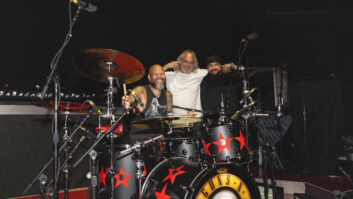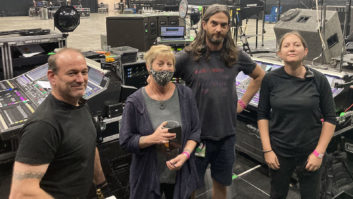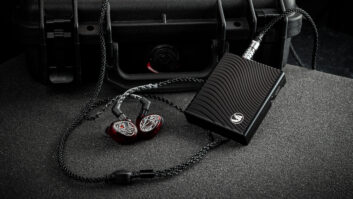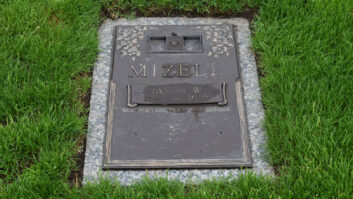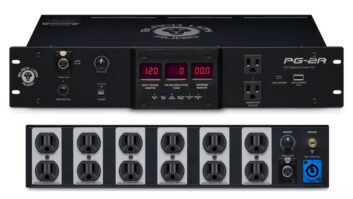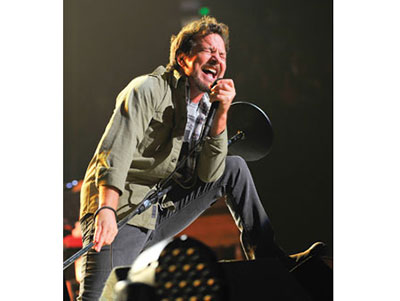
Few bands can claim the live performance track-record of Pearl Jam. Neil Young, The Grateful Dead and Fugazi spring to mind, but Pearl Jam’s ability to deliver visceral, unpredictable performances year after year is remarkable in today’s music landscape.
On their recent 2013 North American tour in support of their new album, Lightning Bolt, Pearl Jam rolled into Oakland’s Oracle Arena on November 26 and delivered a 37-song, 3-hour and 20-minute opus on a Tuesday night, that was ragged and razor-tight in equal measure.
Rat Sound, based out of Los Angeles, has provided the tour package for the Seattle group. Front-of-house engineer Greg Nelson, monitor engineer Karrie Keyes, and systems engineer Kevin McKenzie have all been with the band for at least 10 years and form the core of the audio crew.

Pearl Jam rocked the Oracle Arena in Oakland, Calif., in November 2013. Photo: Steve Jennings
While they have an established way of working, the switch to DiGiCo’s SD5 platform marks a notable change to PJ’s live rig. Nelson, formerly an Avid Venue and Profile user, is still working completely in the box. However, with the SD5, the leap from 48k to 96k allows for greater clarity and definition in the final mix. “There wasn’t a big sonic difference running at 48k between the consoles,” Nelson says, “but running at 96k has really improved the overall midrange and bottom end of my mix.”
The SD5 is just a part of a system-wide approach that DiGiCo has been developing over the past couple of years. McKenzie, who sits at FOH with Nelson and monitors amp and speaker performance during the show, explains, “Every input onstage hits a three-way splitter [recording, house, monitors]. From there it hits a DiGiCo [SD-Rack] that lives under the stage. At that point it is converted to digital, sent via fiber to the FOH surface, then AES out to the Lake system EQ and AES right to the LA8 amps—all at 24/96k. And that really does make a difference.”
Nelson, who has been with the band since 2004, describes his initial approach to dialing in a mix during soundcheck and then on to the first three songs: “The first thing I listen for is how the low end and low-mids are reacting in the room—what frequencies are rolling around that will negatively affect the mix. Is the low end worse in one part of the venue then the other? I think of what can I do to alleviate those factors so everyone in the venue can hear a clean, clear mix. Proper phase alignment is a very important part of the those adjustments.”
Pearl Jam will typically do a 45- to 60-minute full-band soundcheck before each show, working out songs that might appear on that evening’s setlist. “Soundcheck and the show are two completely different things,” Nelson laughs. “Once the show starts, it’s kind of just ‘hold on.’”

Front-of-house engineer Greg Nelson (left) and systems engineer Kevin McKenzie. Photo: Steve Jennings
Nelson admits that mixing the three guitars of singer Eddie Vedder, rhythm guitarist Stone Gossard, and lead player Mike McCready can be challenging, but he’s still able to find clarity. “The guys all have very different guitar sounds, which makes it a bit easier than normal to blend them together. I try to find the differences in tone and try to accentuate those differences so they blend, [while still being able to] differentiate the players.”
Nelson keeps the mix for Vedder, one of rock’s most dynamic vocalists, fairly simple. “[I use] a bit of mild compression and a de-esser,” he says. As for plug-ins, he maintains a less-is-more approach, using them more for color than for serious compression or limiting. “Using the Waves SoundGrid module enabled me to keep using most of the plug-ins I was using before, although I do miss a few of the Avid plug-ins.” Systems engineer McKenzie, who has flown L-Acoustics rigs for more than 10 years with Pearl Jam, has integrated some of the new K1 and KARA boxes for this tour. He says, “Everything in the K1 and KARA is a little bit better than the previous V-DOSC. As a total system, every aspect has been improved from rigging to increased throw, wider horizontal, more bass impact and a greater level of clarity.”
Monitor engineer Karrie Keyes has been with the band longer than nearly any crewmember. Keyes first met them when she was monitor engineer on the Red Hot Chili Peppers’ 1991 Blood Sugar Sex Magik tour (Pearl Jam was the co-opener with Smashing Pumpkins). She continued with the Peppers through 2000 but has been with Pearl Jam ever since that first exposure.
Like her colleagues, Keyes emphasizes a natural, unadorned approach. “The stage has always been organic—getting what they need from the monitors to play a live rock show, [and] one where they can change the set lists up and draw from hundreds of songs each night.”
Pearl Jam’s anything-goes live approach means that Keyes is an active mixer. “I must be involved in the show from start to finish. I watch the entire band, but mainly anything they need is relayed back to me from their techs. My main focus is Ed for the entire show.”

Monitor engineer Karrie Keyes (left) and monitor tech Peter Baigent. Photo: Steve Jennings
For his mix, Keyes says, “Ed takes his vocal, guitars—acoustic and electric—and kick and snare. There are a few cues that he needs keyboards or Mike’s guitar for the intro of songs. Since we started flying sidefills, we have not needed to use reverb except for outside. Other than that there is no compression or effects.”
Trial and error over numerous tours has led Vedder back to using a more old-school approach. “This tour Ed has gotten rid of the in-ears altogether and is using six wedges and the sidefills only. We have just gotten to a point where is he really enjoying the sound onstage. I do not foresee him ever going back to ears.”
As for the rest of the band, she says, “[They are] a combination of ears and wedges.” Keyes delivers six custom mixes to each band member [Vedder, Gossard, McCready, bassist Jeff Ament, drummer Matt Cameron, also of Soundgarden, and keyboardist Boom Gaspar]. In total, Keyes sends out 17 wedge and sidefill mixes, two stereo mixes, and two mono ear mixes. In addition, there are five mono ear mixes and one stereo ear mix for the respective band members’ techs.
“Matt is on wedges only,” Keyes explains. “Stone and Boom use one ear and wedges. Mike and Jeff use stereo ears and wedges. Their mixes are pretty straight forward—a full mix for Stone, mainly guitars for Matt with a bass and guitar [McCready] cabinet. Boom is mainly bass, keys, vocals, kick and snare. Mike and Jeff blend their instruments with kick and mainly put other guitars from Stone into their wedges. Vocals are in everyone’s mix, loud.”
She previously mixed on a Midas Heritage and then a Yamaha PM5D (briefly) but has been using the Midas PRO9 since 2010. “The switch was determined by running out of outputs and inputs, and production savings on not having to ship it worldwide,” she notes. As for wireless, the band uses a Sennheiser G2 system, which they own.
Pearl Jam has recorded their performances since 2000, releasing them in various formats as part of their ongoing live bootleg series. Recording engineer John Burton describes the process as follows: “Grace M802 mic preamps into Pro Tools 9 using the 192 I/O [with] 72 inputs, recording [to] 96k/24-bit WAV. Multi-track hard drives are sent to [longtime live mixer] Brett Eliason to mix. The mixes are mastered at RFI for CD, HD FLAC, FLAC and MP3 256 VBR.”
It’s clear that the sound crew shares the band’s natural, music-first philosophy. “I think dynamics are a really important part of any live show,” Nelson says. “It helps a show become more dramatic. If you are trying to make all the quiet songs the same level as the loud ones, then it diminishes the impact of those big, loud songs. That’s where using a lot of plug-ins can hurt you sometimes. I think a live mix should breathe.”
